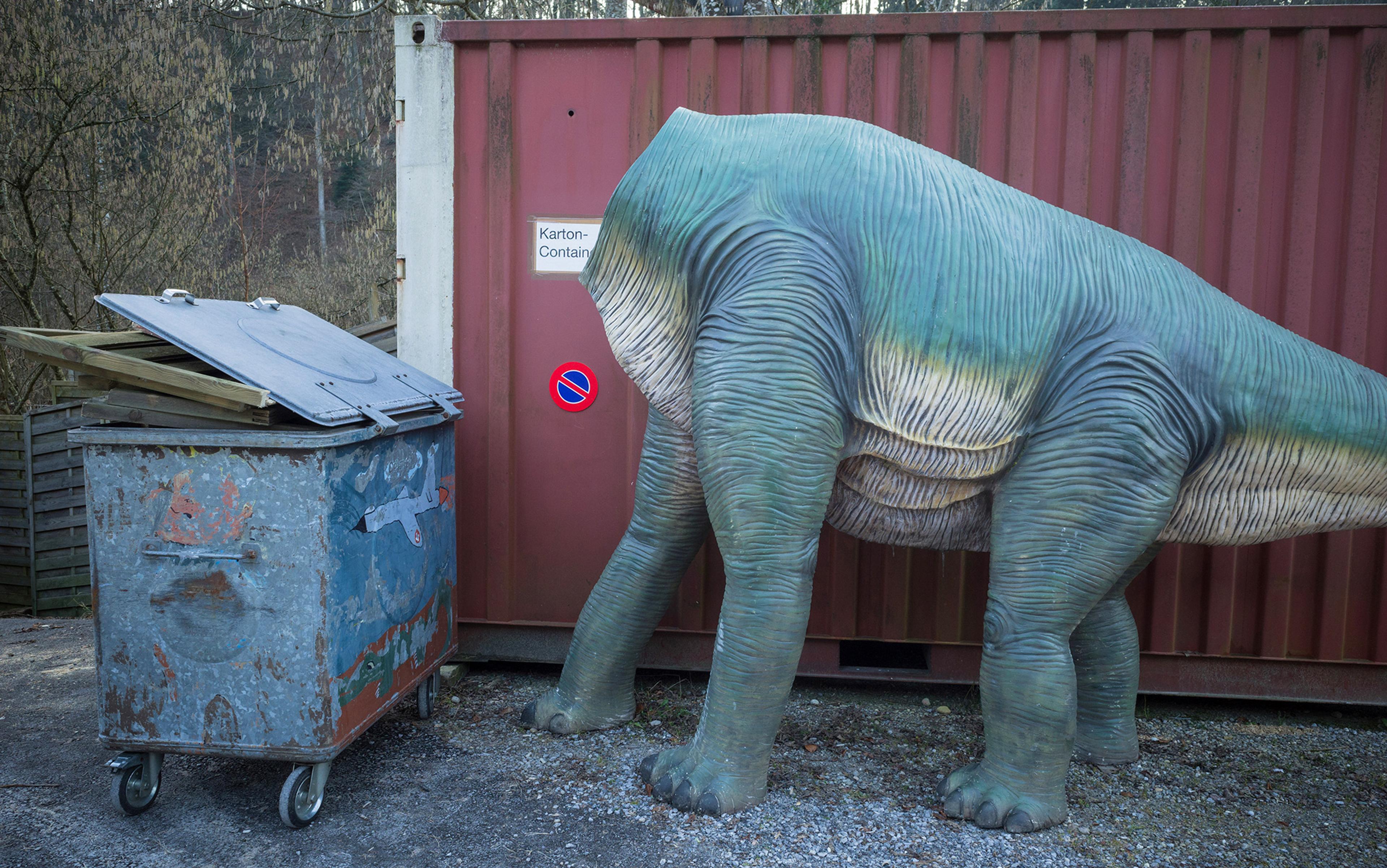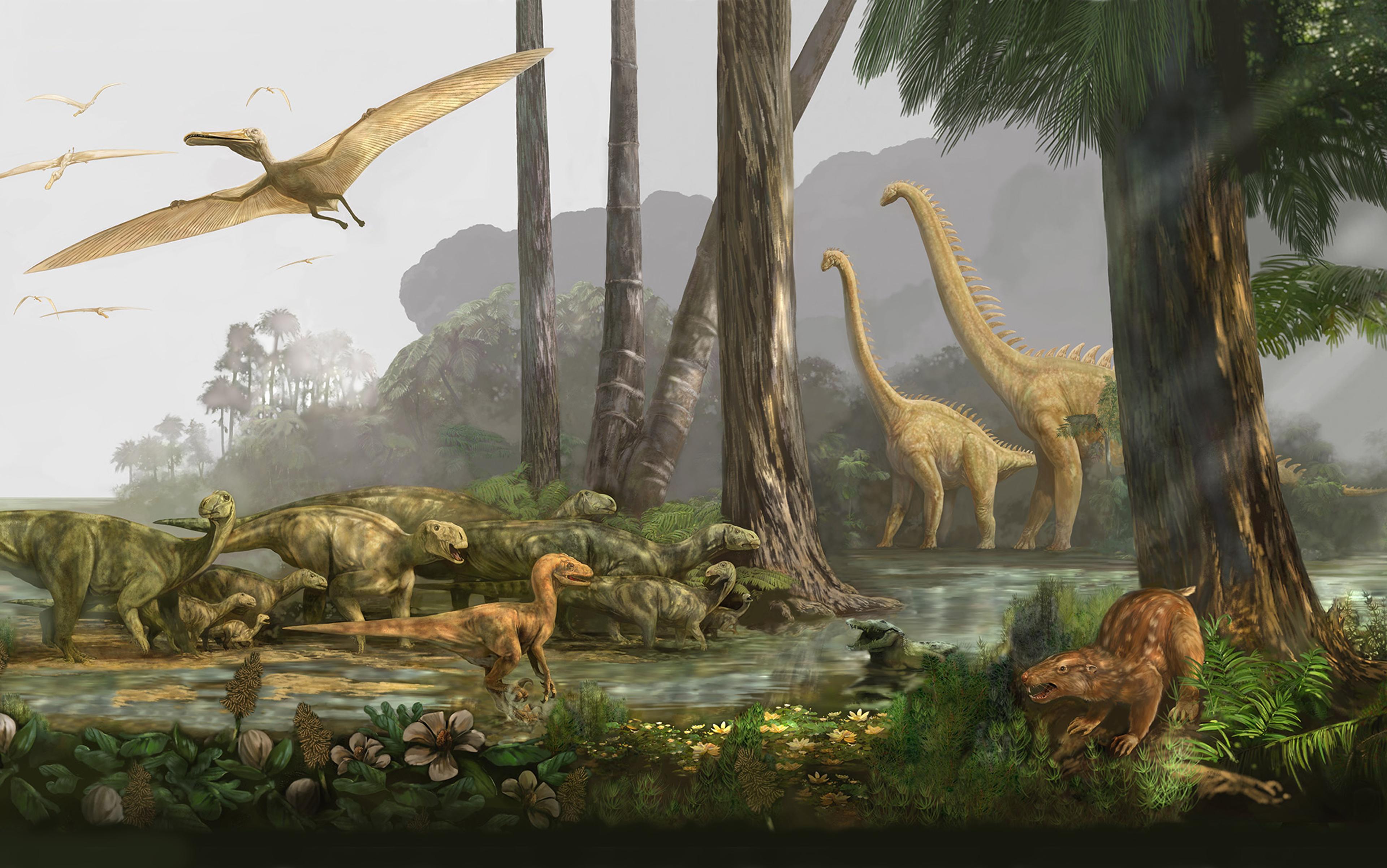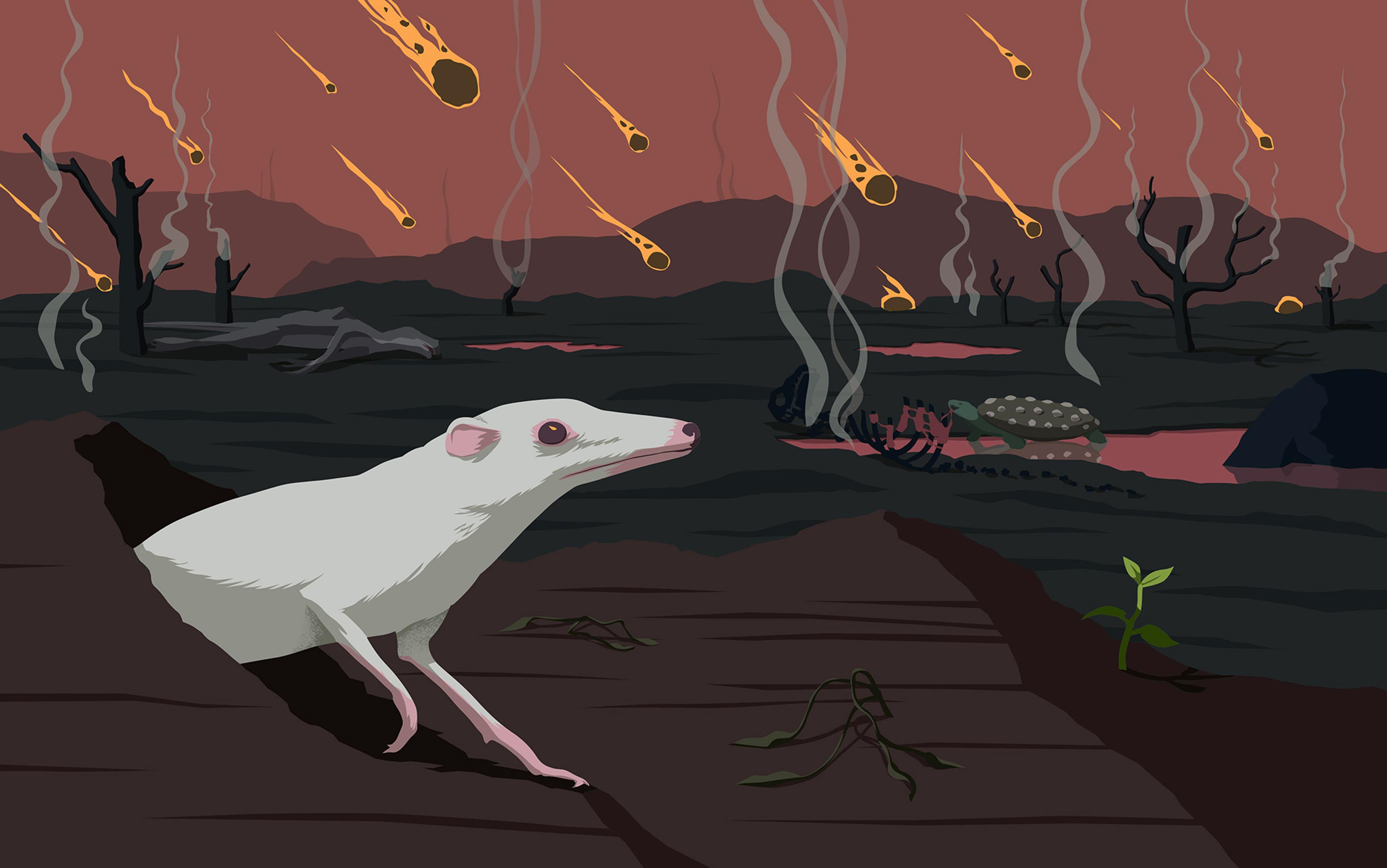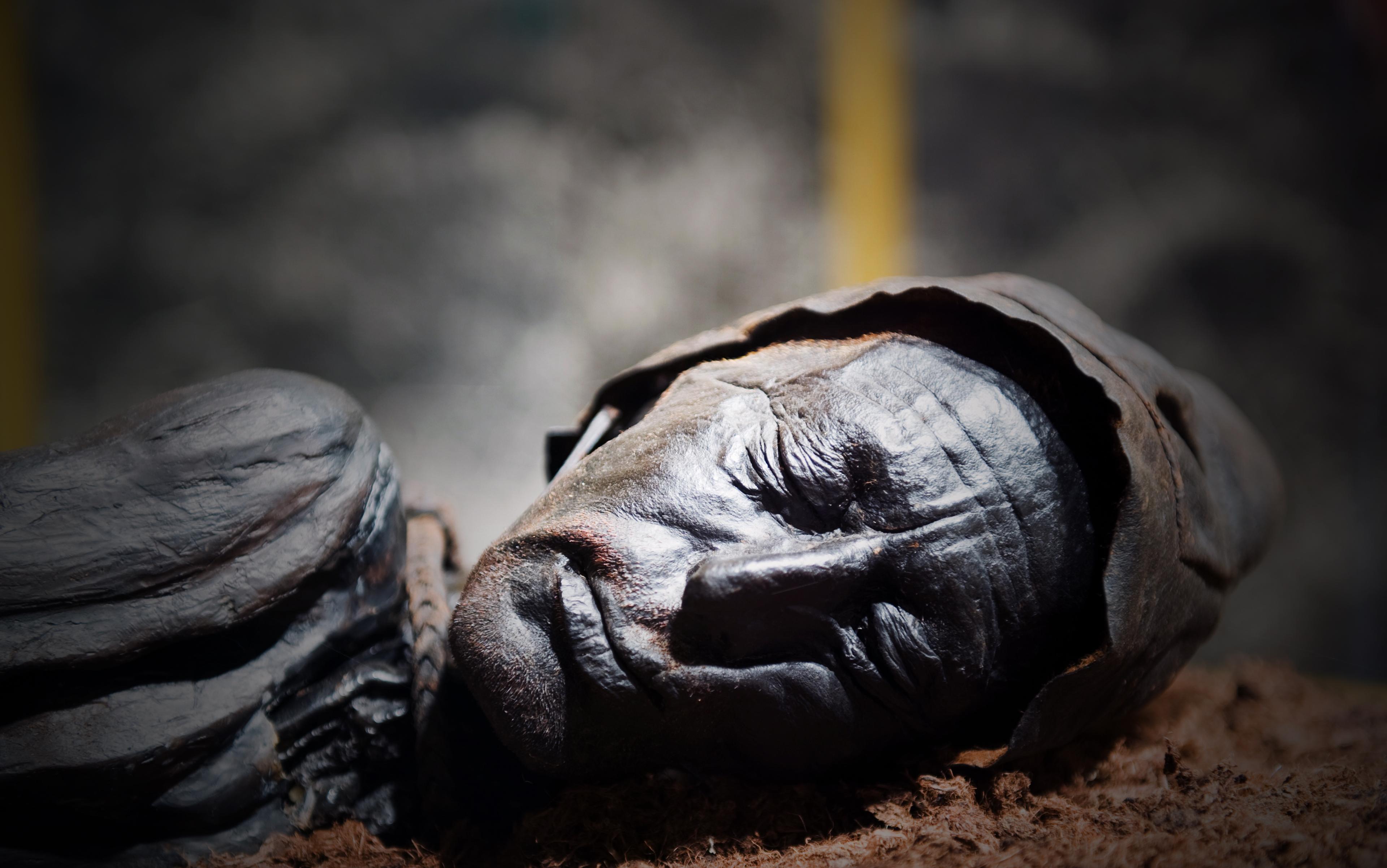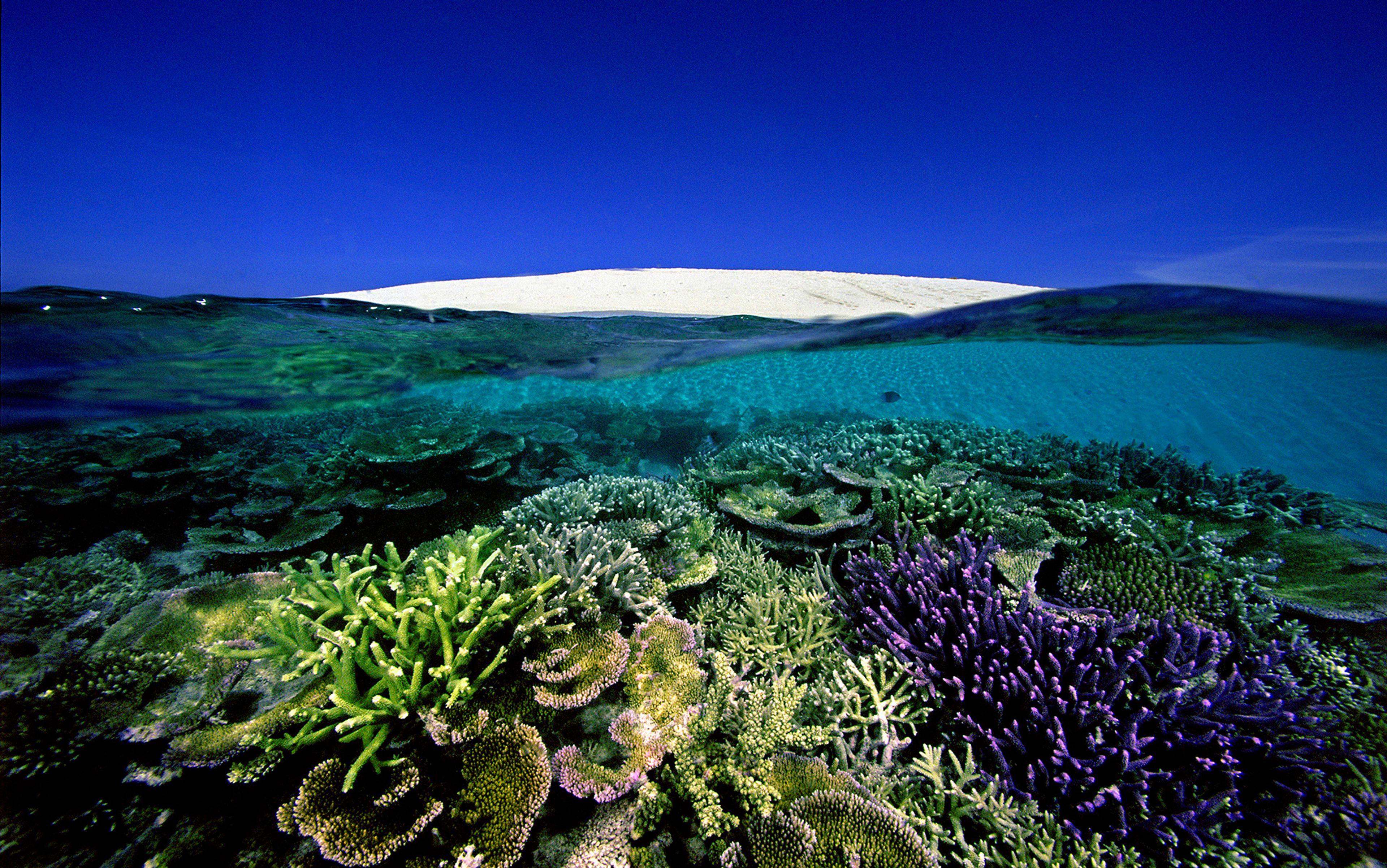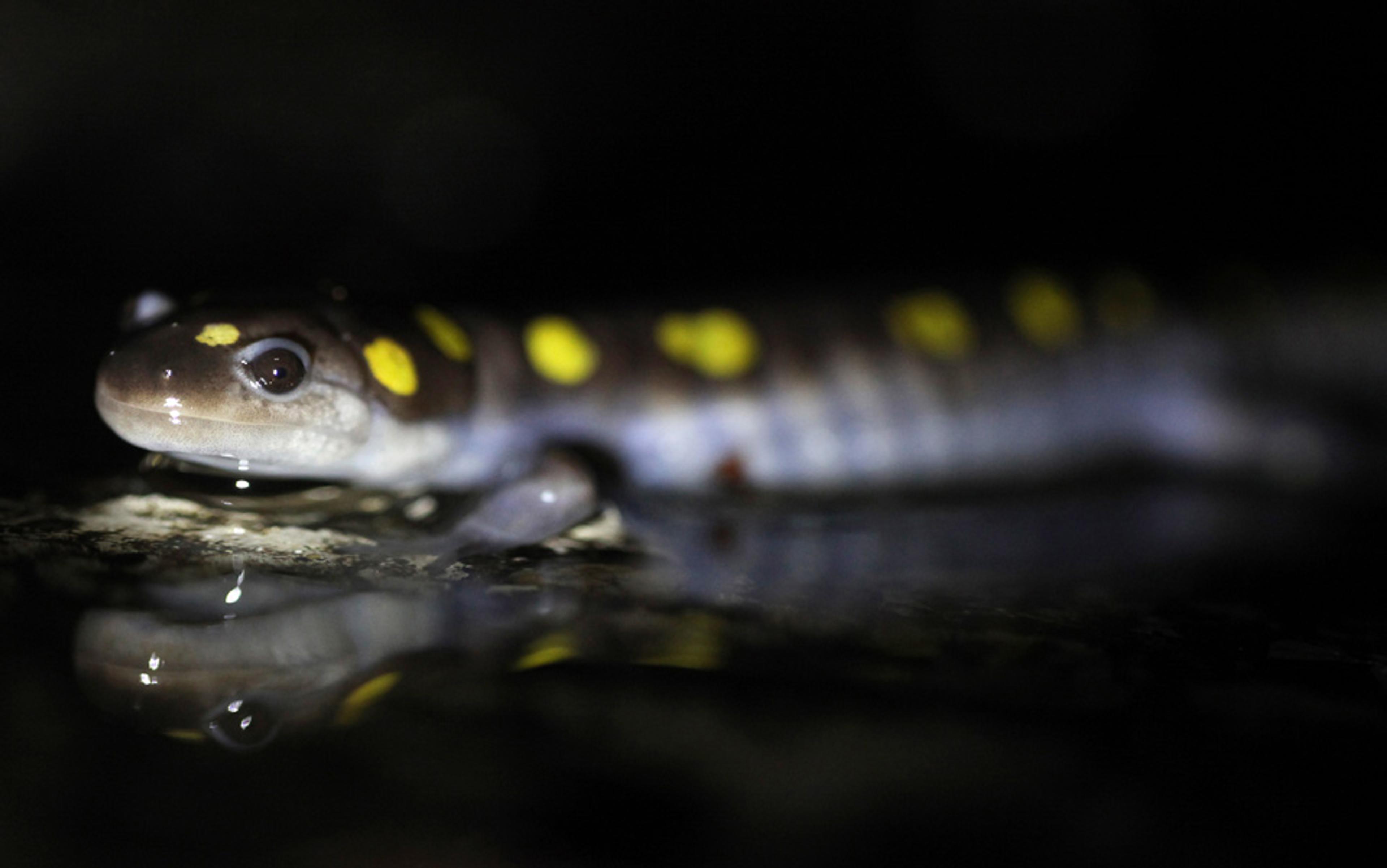Of all the species that have ever lived on our planet, more than 99 per cent are extinct. Most of these organisms disappeared through the constant shuffle of ecological and evolutionary change. But not all. Many species have vanished in a geological snap during mass extinctions – truly catastrophic events where the rate of extinction vastly outpaces the origin of new species. For a time, these ecological disasters were thought to drive a great flourish of new lifeforms in the aftermath. It turns out that supposition is wrong.
Consider the cataclysm that ended the Cretaceous Period around 66 million years ago. A chunk of space rock more than 7 miles wide smacked into what’s now the Yucatán Peninsula. The debris and ejecta thrown into the atmosphere heated up on the way back down, causing oven-like temperatures all over the planet before a chilly post-impact winter settled in, almost halting photosynthesis for three years. Before the impact, the likes of Tyrannosaurus and Triceratops were thriving. After, only birds were left to carry on the legacy of the ‘terrible lizards’ in what would eventually be called the Age of Mammals. The impact, palaeontologists used to argue, toppled dinosaurs from dominance and allowed our mammalian relatives and ancestors to thrive. A mass extinction, in other words, was the prerequisite for a new evolutionary burst that featured mammals.
But the classic tale of extinction and recovery doesn’t hold up anymore. What the fossil record tells us about the nature of life on Earth does not line up with the traditional view in which mass extinctions refresh life’s diversity as if they were blazes required to reinvigorate fire-adapted forests. Life’s greatest radiations, palaeontologists are learning, were decoupled from mass extinctions. Instead, those radiations seem to have come when organisms transcended anatomical and environmental barriers to inhabit a new niche. The origin of complex eyes, the interplay of species as some organisms became adapted to land, and similar events were far more important than mass extinction to evolution’s most vigorous moments in time – a testament to the complexity of our planet’s biodiversity and a warning for life’s future on this planet.
The very concept of extinction is relatively recent. Consider the fate of the dodo. The large, ground-dwelling pigeons found on the island of Mauritius were extremely vulnerable to the rats, dogs and pigs European sailors brought with them – not to mention the depredations of the seafarers themselves. In less than a century, the dodo was entirely exterminated – the most commonly accepted date for the bird’s demise is 1662. And yet, despite the fact that humans both caused and witnessed extinction firsthand, many naturalists doubted that extinction was even possible. It wasn’t until 1799, more than 100 years later, that extinction was finally accepted as an inescapable facet of nature.
Fossils provided the key. While interpretations of these petrified remnants by early naturalists in Europe verged on the fanciful in order to square the fossil record with Christian scripture – for example, that fossils are merely imitations of life that grow inside the rock of their own accord – by the late 18th century it was accepted that fossils were the remains of ancient creatures. But this, by itself, did not prove extinction. The 18th century was a burgeoning era of exploration and colonialism, and naturalists were awed by just how varied and strange the world was. Perhaps some of the giant elephants or enormous sloths might be wandering some distant grassland or unseen forest. But by 1800, the work of a young French anatomist named Georges Cuvier put the proverbial nail in the coffin of the subject of extinction.
Cuvier’s studies had trained him in comparative anatomy, a relatively new science that focused on reading animal bodies to understand the organisation of nature. During his research, he pored over the remains of an elephant-like animal found in Siberia, as well as the skeletal remains of a similar animal dubbed the ‘American incognitum’. Until that time, such remains were either considered to be the bones of elephants that had wandered to unusual latitudes when the world was warmer, or clues to rare species still awaiting discovery, alive, in some distant part of the world. But Cuvier convincingly argued that the bones of the Siberian animal and the American creature were not only different from each other, but distinct from any living species. More than that, Cuvier noted, these were large animals that would be unlikely to go unnoticed during a time when natural observations and study specimens were pouring into Europe from all over the globe. Species could go extinct, and already had been long before humanity.
Life certainly changed over time, but it seemed to do so in a progressive and orderly fashion
Additional finds quickly bolstered the point. Another animal intimately familiar to Cuvier – Mosasaurus – was a gigantic sea lizard unlike anything swimming in modern waters. No one had seen anything quite like the giant sloth Megatherium alive among the pampas of Argentina, either. Stranger still were creatures that in 1842 would be dubbed the dinosaurs, reptiles that did not look like any lizard or crocodile. Nevertheless, during palaeontology’s early development, there was no sense of Deep Time or how ancient the world truly was. It was impossible to say precisely how old Earth might be and when these bizarre creatures lived. All palaeontologists were left with was the appearance of progress through time, the layers of Earth’s rocks seeming to fall into an Age of Fishes, an Age of Reptiles, and an Age of Mammals. (Only in 1859 did naturalists begin to concede that Homo sapiens, too, had a fossil record.)
Life certainly changed over time, but it seemed to do so in a progressive and orderly fashion neatly arranged along a trajectory of lower to higher vertebrates. Even though some experts – such as Cuvier himself – advocated for intermittent catastrophes that ended one age and ushered in another, many naturalists took a different view. Life evolved and went extinct like clockwork, a constant and persistent turnover as gradual as the erosion of a rock.
It didn’t take long for cracks to form in these classic notions of extinction. In fact, in the decades between the publication of Charles Darwin’s On the Origin of Species (1859) and the modern evolutionary synthesis (combining Darwin with ideas about genetics) that coalesced in the 1940s, palaeontologists proposed some wild ideas. Some played with notions of orthogenesis, or the idea that groups of organisms had internal life-timers – just like individuals – that dictated birth, growth and death. In the book The Origin and Significance of Spines (1898), for example, the American palaeontologist Charles Emerson Beecher argued that the coil-shelled squid cousins called ammonites got spinier and spinier over time – a term he called ‘spinescence’. That showed how natural systems broke down as a group of organisms self-destructed. Dinosaurs, too, were prime examples of the trend. Many of them were large, strange and lavishly ornamented, and they had all disappeared to make way for the superior mammals. With orthogenesis in play, there was no need to understand extinction as an ecological process or something that could happen suddenly.
But by the latter half of the 20th century, the modern synthesis had put natural selection back at the centre of evolutionary considerations, and old ideas about orthogenesis and ‘spinescence’ were tossed out. Instead, finally, extinction was understood as an inevitable phenomenon influenced by alterations to an organism’s environment. During the 1980s in particular, the burgeoning science of palaeobiology started to look beyond individual fossil finds for broader patterns in life’s history. By looking at the comings and goings of oceanic invertebrates, for example, researchers such as David Raup and John Sepkoski discerned that there were at least five dramatic extinction waves, or ‘pulses’, when species vanished en masse. The pattern was observed in the terrestrial realm, too, underscoring that Earth’s biodiversity had repeatedly gone through crashes and recovery.
Over time, palaeontologists began to realise how these events cleared the ecological decks and allowed new forms of life to arise. Consider the worst mass extinction of all time, the end-Permian mass extinction that occurred around 252 million years ago. Prior to that event, the world was brimming with complex ecosystems – from ancient ocean reefs to forests prowled by protomammals. Then, intense volcanic activity triggered severe global changes ranging from ocean acidification to depleted oxygen in the atmosphere, resulting in about 70 per cent of land-dwelling species and more than 90 per cent of marine species going extinct. In the following time period, the Triassic, reptiles – including the earliest dinosaurs – replaced the protomammals as the dominant vertebrates on land. A mass extinction had lopped off numerous branches of the tree of life, allowing the survivors to evolve in new ways as life’s biodiversity refreshed itself.
Life on Earth seemed to be cut back by catastrophe, and then emerge from the ashes more varied and vigorous than before. Mass extinctions reshaped nature, it seemed, shuffling off ancient lineages and allowing new forms to burst forth. The Age of Fishes, the Age of Reptiles and the Age of Mammals that early palaeontologists perceived didn’t mark life’s ascension, but the legacy of mass extinctions – each new age representing how life had come back in fuller force. That evolution would be reinvigorated after the decimation of many species seemed to be intuitive.
They didn’t find a neat relationship between extinction and increased biodiversity
But the fossil record no longer bears out this pattern of devastation and vigorous renewal. Even though what we know of prehistoric life comes to us in fragments – a fraction of a fraction of a fraction of all life that ever lived – palaeontologists have been able to at least outline the ebb and flow of life through time. The trend doesn’t match the classic narratives around mass extinctions. In most cases, the times when life truly thrived were decoupled from mass extinctions.
Over the years, palaeontologists have catalogued literally millions of fossil occurrences in the Paleobiology Database, an immense store of information that outlines the shape of life through time.
By drawing on this information, the data scientist Jennifer Hoyal Cuthill at the University of Essex and colleagues used machine learning to track major shifts in species diversity over the past 541 million years. The mark of biodiversity disasters was unmistakable. The researchers noticed the traditional Big Five mass extinctions, as well as an additional seven. Broadscale catastrophes are not nearly as rare as had been previously thought. But when the scientists looked at when life bloomed, they didn’t find a neat relationship between extinction and increased biodiversity. Of 17 events that the researchers called ‘mass radiations’ of life, only two seemed to be associated with a mass extinction.
One of the times that stood out in the new analysis is a slice of prehistory known as the Carboniferous. Hoyal Cuthill and colleagues noticed a major diversity spike at around 358 million years ago, at the beginning of the period. This was a time when new plant species were rapidly evolving on land, providing entirely new ecosystems for terrestrial invertebrates – from ancient millipedes to dragonflies – and the amphibious vertebrates that lurked at the water’s edge, looking for insects to munch. Life transcended the aquatic realm to come ashore, with entirely novel ecosystems taking root. There’s no evidence that a mass extinction had anything to do with this burst. The last mass extinction was more than 7 million years earlier, too ancient to have spurred the profusion of plants and animals that evolved to thrive on land.
But there was something else, perhaps easy to miss on first glance. Hoyal Cuthill and her co-authors didn’t just look at when mass extinctions or radiations occurred. They also examined when species appear and disappear from the fossil record to get some sense of how sharp each of these changes were. During the Cambrian Explosion of 541 million years ago, for example, 87 per cent of known species first appear in the fossil record and only about 12 per cent of species disappear. Just like the name suggests, the Cambrian Explosion was a major burst of evolutionary novelty. But when the researchers looked for the event’s inverse – a time when most species go extinct and few appear – the closest they could find was the end-Permian mass extinction that occurred 289 million years later, when 73 per cent of species went extinct and only 19 per cent appeared in the fossil record. The way mass extinctions and mass radiations play out doesn’t match with each, and they aren’t even related to each other. And that tells us something fundamental about the shape of life on Earth.
Naturalists of old envisioned the history of life as the story of progress, of life becoming more advanced and complex through the ages in a way that upholds humanity as the highest form of life. Those notions were replaced by a vision of ecosystems that do not have a preordained direction but are always building up to similar layers of complexity, just as a forest might go through multiple stages before reaching a ‘climax community’ of many interacting species. It’s a view that sees life through time almost as a glass that is filled, drained, and filled to a similar level again, reaching a particular point where ecosystems seem more or less stable with a full complement of producers, herbivores, carnivores, omnivores, scavengers and so on, taking up the available ecological space.
But the new results reveal that life is not constantly striving to reinvent the same relationships or reach the same waterline time and again. Sometimes, due to an environmental shift or the origin of an evolutionary novelty such as eyesight, species rapidly diversify in response. Other times, ecological shifts quickly and dramatically cut back many species almost in the same instant, but without any promise that the previous order of life will be replayed or restored. The shape of life’s diversity is far more varied and responsive than we previously understood, with evolution’s greatest radiations usually having little to do with mass extinctions.
Palaeontologists have already begun accumulating evidence for this new view of life’s rhythm through Deep Time. The change even touches upon our own prehistory and how our present Age of Mammals rose out of the wreck of the Cretaceous world.
During the Age of Reptiles, the traditional story goes, mammals were small, insect-snatching creatures that lived in fear of the great saurians. Mammals thrived only when the asteroid struck at the end of the Cretaceous, decimating the dinosaurs. But multiple studies have underscored how this story isn’t true.
Prehistoric relatives of ours called mammaliaformes pioneered niches similar to those of raccoons, otters, flying squirrels, anteaters and other beasts familiar to us today. They were so successful that they temporarily shouldered out our more direct mammalian relations. In short, the complexity of mammal diversity had a greater effect on our evolutionary pedigree than the presence or absence of T rex and company.
Portraying the evolutionary burst our mammalian kin underwent as dinosaurs merely ceding the stage no longer holds up. It was not simply the absence of the dinosaurs that made the difference. If anything, the formative millennia of mammalian evolution owe a greater debt to other ecological changes that occurred in the postimpact world. While conifers, ferns, cycads, horsetails and similar plants were extremely common during the Age of Reptiles, angiosperms – or flowering plants – became far more prominent in the early days of the Age of Mammals. A world warmed by greenhouse gases allowed these new forests to flourish, and a lack of large animals allowed them to grow thick into multitiered environments where the species in the canopy might be very different from those on the forest floor.
On top of that, the palaeontologist Meng Chen and colleagues have observed, many of the mammal lineages that survived the effects of the asteroid strike had a multipurpose molar shape that gave them a literal edge in adapting to new foods – be it fruits and leaves, insects and even other mammals. Competition for resources likely led to what ecologists call niche partitioning – or animals adapting to rely on different resources and ways of life in the same habitat – and spurred the diversity of the mammals. It wasn’t as if mammalian evolution had some fuse that was just ready to trigger their evolutionary moment. Rather, conditions changed, providing untold opportunities for varieties of life.
The particulars of our choices may alter life’s history for far longer than we’d otherwise expect
There’s no single happenstance or evolutionary force that sparks these bursts. There’s no rhythm to the pattern. It’s not as if prehistoric climate or sea level, some other factor creates just the right conditions. The secret to life’s greatest blooms lies in the way organisms affect each other as they adapt and evolve.
Consider the Cambrian Explosion, a time between 541 million and 531 million years ago when animal life rapidly evolved into forms so confounding that it can take palaeontologists decades to figure out what sort of creature a given Cambrian animal is. The metre-long predator Anomalocaris – with its compound eyes, grasping appendages, and shutter-like mouth – initially and mistakenly had its various body parts described as different species. Only when a relatively complete specimen turned up did palaeontologists realise that all these pieces went together. The undersea velvet worm Hallucigenia is yet another example, an animal so unfamiliar that it was originally envisioned as walking on the long spikes sticking out of its tubular body – a position experts later realised was upside down. These creatures – and many, many more – were part of an unprecedented evolutionary burst.
There was no mass extinction that set up the Cambrian Explosion. Instead, life seems to have crossed some sort of threshold – just as animals did during the Carboniferous when they came onto land. In the case of the Cambrian, it’s likely that the origin of eyesight had a major role to play in the arrival of many new species. Whereas some of the earliest animals might have been able to perceive only light and dark – tracking days and nights, or the shadow of a predator moving overhead – by the Cambrian, animals were evolving increasingly complex compound eyes. Predators became more adept at capturing prey. Prey became more attuned to the movements of species that might snack on them. Vision that was more precise kicked off an evolutionary push-and-pull that helped spur the origin of new defences, new ways to catch prey, and other shifts that underwrote the burst of Cambrian species. It’s from these changes, when life crosses some environmental or anatomical threshold, that organisms evolve in startling new ways.
Life’s behaviour in the past can give us a hint about what’s to come. We are presently going through what some ecologists have deemed a sixth mass extinction, a time when we’re losing species faster than new ones are evolving. Under the old view, we might expect that whatever species manage to survive humanity’s alterations to the planet will rapidly bounce back in a profusion of new forms. The pressure of extinction would be released into a new biodiversity high. But the emerging picture doesn’t track with such an expectation. The particulars of our choices may alter life’s history for far longer than we’d otherwise expect. Life might not recover in a million years’ time. Instead, whatever biodiversity peak life reaches may rely on the accidental nature of evolution itself. Whatever species survive humanity’s presence will proliferate, interact in new ways, and usher in inconceivable ecosystems.
Whether applied to our mammalian forebears or some of the first animals of 541 million years ago, life’s diversity isn’t reliant on mass extinctions for evolutionary inspiration. Life comes roaring forth when species begin to transcend a boundary – such as plants beginning to grow on land – or when interactions between species nudge biodiversity into new niches, as was the case with beasts in the heyday of the dinosaurs. Instead of moving to a steady beat, punctuated by relatively few record scratches, life’s tempo is full of unexpected and asymmetrical time changes, a cacophonous riot of life.
